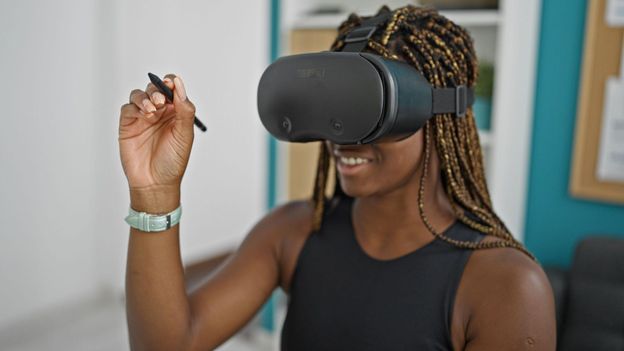
Key Takeaways:
Escaping the Monotony: How AR and VR Take Video Meetings to the Next Level
In today’s fast-paced world, video meetings have become an integral part of remote work. However, long hours of staring at a screen in a static environment can lead to monotony and decreased productivity. With advancements in technology, we now have the power to break away from the mundane and embrace a more immersive and engaging meeting experience through the use of Augmented Reality (AR) and Virtual Reality (VR).
Transforming Online Collaboration
Gone are the days when video meetings were solely reliant on traditional video conferencing platforms offering only basic features. AR and VR have brought a new level of innovation to online collaboration, allowing us to escape the confines of the screen and enhance communication and collaboration in remarkable ways.
With AR, participants can overlay digital information on the physical world, enriching the video meeting experience. Imagine being able to share virtual 3D models and manipulate them in real-time during a collaborative design review. This level of interaction opens up endless possibilities for professionals in various fields, including architecture, engineering, and product design.
VR, on the other hand, creates a fully immersive virtual environment, transporting participants to a different reality. Instead of staring at your static video image on screen, you can enter a lifelike virtual meeting room where you can see and interact with others as avatars. This gives a sense of presence and fosters a more natural and engaging conversation, making you feel as if you are physically present with your remote colleagues.
Advantages of AR and VR in Video Meetings
The integration of AR and VR technologies in video meetings offers numerous advantages:
- 1. Increased Engagement: AR and VR create a dynamic and interactive environment that captures participants’ attention and keeps them engaged. By incorporating visual elements, 3D models, and gamification elements, meetings become more than just voice and video interactions, making collaboration more stimulating and effective.
- 2. Enhanced Communication: AR and VR eliminate the barriers of physical distance, allowing participants to feel more connected and immersed in the meeting. Non-verbal cues and gestures can be communicated more naturally, increasing understanding and reducing miscommunication that can occur in traditional video meetings.
- 3. Improved Collaboration: The ability to manipulate virtual objects or work together on digital models in real-time during meetings greatly enhances collaboration. Decision-making becomes more efficient and a deeper level of understanding can be achieved when everyone can visualize and interact with the same virtual elements simultaneously.
- 4. Productivity Boost: By breaking away from the monotony of traditional video meetings, AR and VR spark creativity and keep participants energized. Employees are more likely to maintain focus, leading to improved productivity and better outcomes.
Incorporating AR and VR into Video Meetings
Implementing AR and VR technologies into video meetings might seem daunting, but it’s becoming increasingly accessible and feasible for businesses of all sizes.
For AR, all you need is a compatible device, such as a smartphone or a tablet equipped with AR capabilities. With the help of AR software platforms or dedicated apps, participants can join in the augmented reality world seamlessly. They can visualize 3D models, interact with them, and share annotations, all in real-time.
Voice commands and gestures can also be utilized to enhance user experience, allowing for a hands-free approach during AR-enhanced video meetings. This level of interactivity sets the stage for engaging and intuitive collaboration sessions.
VR, on the other hand, typically requires more specialized hardware, such as VR headsets. These devices create an immersive environment by blocking out the physical world and replacing it with a virtual one. While VR headsets are more commonly used in gaming, their application in business settings is growing rapidly.
However, it’s important to ensure that all participants have the necessary hardware and a stable internet connection before incorporating VR into video meetings. This will avoid exclusion and ensure a consistent and inclusive experience for everyone involved.
Utilizing AR and VR for the Future of Work
As remote work continues to gain prevalence, organizations are constantly seeking ways to foster seamless collaboration and engagement among their teams. AR and VR offer exciting opportunities to transform how we connect and work together, providing a glimpse into the future of remote collaboration.
Imagine taking part in a VR brainstorming session where everyone can jot down ideas on a virtual whiteboard or examine 3D models from different angles. Alternatively, AR can enable employees to bring their remote workspace to life by overlaying useful information, such as virtual sticky notes or productivity widgets, directly in their physical environment.
These technological advancements have the potential to bridge the gap between physical and virtual presence, creating a sense of belonging and shared experiences. They may also revolutionize training programs by enabling immersive simulations and providing hands-on experiences, regardless of participants’ physical locations.
Frequently Asked Questions
Conclusion
Escaping the monotony of traditional video meetings is now possible with the integration of AR and VR technologies. These immersive and engaging experiences provided by AR and VR can transform online collaboration by increasing engagement, enhancing communication, improving collaboration, and boosting productivity. Whether it’s overlaying virtual objects or entering a virtual meeting room, AR and VR take video meetings to the next level. By embracing these technological advancements, businesses can revolutionize remote work and pave the way for a future of work that is both dynamic and impactful.
Source: insidertechno.com